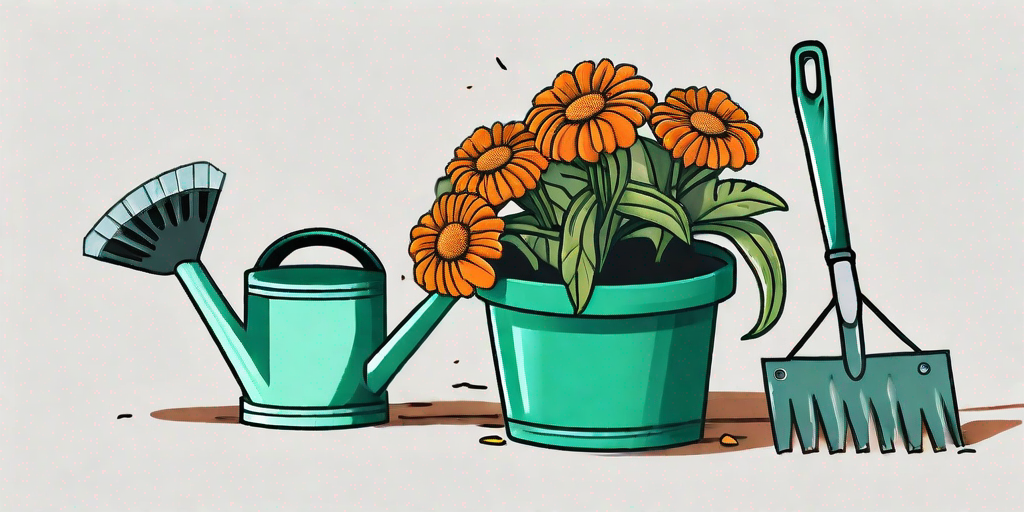
If you're reading this, it's likely that your marigolds are looking more miserable than merry. But don't fret, dear gardener. This isn't a eulogy for your flowers. Instead, consider this a resurrection guide, a beacon of hope in the face of wilted petals and drooping stems. We're here to troubleshoot your marigold misery and transform it into marigold magic.
Understanding Your Marigold's Mood
First things first, let's get to know your marigold a little better. Marigolds are like the divas of the plant world. They're bright, beautiful, and when they're not happy, they sure know how to show it. But, just like any diva, they have their needs and wants. Understanding these is the first step to reviving your marigolds.
Marigolds love the sun. They're like sunbathing enthusiasts, basking in at least six hours of sunlight each day. They also prefer well-drained soil and aren't fans of too much water. Overwatering is like giving them a soggy sandwich - it's just not appreciated.
Signs of a Sad Marigold
So, how can you tell if your marigold is unhappy? Well, they're not exactly subtle. If your marigolds are wilting, turning yellow, or dropping leaves, they're sending you a clear distress signal. It's their way of saying, "Hey, something's not right here!"
Other signs of a sad marigold include stunted growth and a lack of flowers. If your marigolds are more stick than bloom, it's time to take action.
Reviving Your Marigolds
Now that we've identified the problem, let's get to the fun part - bringing your marigolds back to life. It's like a plant-based episode of a medical drama, but without the dramatic music and cliffhangers.
Reviving your marigolds involves a few key steps. Let's break them down:
Step 1: Check the Watering
Remember, marigolds aren't fans of soggy soil. If you've been a little too generous with the watering can, it's time to ease off. Allow the soil to dry out between waterings, and when you do water, aim for the base of the plant rather than the leaves.
Think of it like this - your marigolds prefer a refreshing drink, not a full-on shower.
Step 2: Let There Be Light
Ensure your marigolds are getting enough sunlight. If they're in a shady spot, consider moving them to a sunnier location. Remember, they're sun worshippers, not vampires. They thrive in the light, not the dark.
If moving them isn't an option, consider using a grow light to supplement their sunlight intake. It's like giving them a sunbed session, but without the risk of a bad tan.
Step 3: Feed Them Well
Marigolds aren't fussy eaters, but they do appreciate a good meal. A slow-release fertilizer can work wonders for your marigolds, providing them with the nutrients they need to grow and bloom.
But remember, moderation is key. Over-fertilizing can cause more harm than good. It's like overfeeding a pet - too much of a good thing can lead to problems.
Preventing Future Marigold Misery
Now that your marigolds are back on track, let's ensure they stay that way. Prevention is better than cure, after all. Here are some tips to keep your marigolds happy and healthy:
Tip 1: Regular Check-ups
Keep a close eye on your marigolds. Regular check-ups can help you spot any issues early on, allowing you to take action before they become serious problems.
Think of it like taking your car for a service. Regular maintenance can prevent breakdowns and keep things running smoothly.
Tip 2: Practice Good Hygiene
Keep your garden clean and tidy. Remove any dead leaves or flowers from your marigolds to prevent disease and pests. It's like giving your marigolds a regular spa day - they'll appreciate the pampering.
Also, clean your gardening tools regularly. Dirty tools can spread disease, and your marigolds certainly don't need that kind of drama.
Tip 3: Rotate Your Crops
If you're growing marigolds in the same spot year after year, consider rotating your crops. This can help prevent soil-borne diseases and pests. It's like giving your soil a vacation - a chance to rest and rejuvenate.
Plus, it's a great excuse to mix things up in your garden and try something new.
Frequently Asked Questions
Still got questions? Don't worry, we've got answers. Here are some frequently asked questions about marigold care:
Why are my marigolds turning yellow?
Yellowing leaves can be a sign of overwatering or a lack of nutrients. Check your watering habits and consider using a slow-release fertilizer.
Why are my marigolds not blooming?
Marigolds need plenty of sunlight to bloom. If your marigolds aren't flowering, they may not be getting enough light. Consider moving them to a sunnier spot or using a grow light.
Can marigolds recover from overwatering?
Yes, marigolds can recover from overwatering. Allow the soil to dry out, then resume watering sparingly. Remember, marigolds prefer a drink, not a shower.
So, there you have it - a comprehensive guide to troubleshooting your marigold misery. With a little care and attention, your marigolds can go from sad to spectacular. Now, go forth and garden with confidence!















